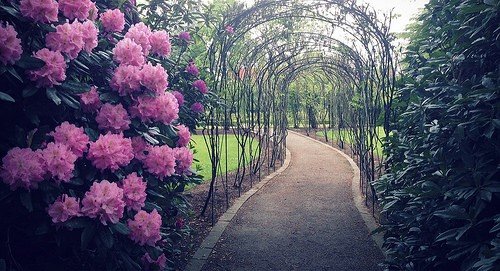With a stunning path, a garden can become so much more than a place to grow plants or harvest fruits and vegetables. A garden path can enhance the design of the entire home, give you a place to relax or meditate, and serve as the cornerstone of your property’s landscaping. But there’s more to consider than simply connecting point A to point B. Here are three strategies for finding the appropriate placement for a garden path.
Start With Functionality

Image via Flickr by Nick Kenrick
To lay out the perfect garden path, you’ll first need to outline your needs and wants. Do you simply want to create a path leading from the driveway to the front door? Or do you want a winding trail that guides visitors along your prized vegetation? Perhaps you just want easier access to your backyard. There are many design options to think about, from elegant curves to straight lines and more unique pathways. Consider designing your path around a focal point, such as a fountain, or using a winding layout to showcase a parterre full of ornamental flowers.
Prioritize Aesthetics
The adage “form follows function” is true in laying out the perfect garden path, but don’t discount the importance of aesthetics. Once you’ve defined your needs, look at how you can optimize the appearance of the path while preserving its functionality. There are a few ways you can do this:
- Selecting the right garden path materials: From paved stone walkways to stepping stones and even limestone slabs, you’ll need to pick the right material to create the effect you want. You’ll also need to think about how much maintenance you’re willing to do. For example, stone walkway pavers are universally durable, whereas limestone and marble require a sealer for outdoor use.
- Adding lights to guide the way: A quality path requires more than picking the right material. Take a step back and look at the space around the future walkway. Mushroom lights can be placed to illuminate trees and other landmarks in your yard, and LED paver lights can be used to brighten the path itself.
- Placing outdoor seating along the path: Consider where you’ll place outdoor seating when you lay out the path. Look for a level area where an outdoor hammock or sofa could go. Alternatively, you could work with a designer to create a stone bench that’s part of the path itself.
Use Flora to Highlight the Path
Even the best path will be disappointing without a quality garden full of stunning plants. The options available to you will depend on the season, the amount of sunlight available, and your geographic location. Regardless, consider a healthy variety to create an interesting space.
Try a mix of trees, shrubs, ground covers, and flowers, and consider how the layout of the path can but used to highlight these items. For example, a winding path can whimsically draw the viewer from one flower bed to the next, whereas a straight path is a good opportunity for symmetrically placed trees or bushes.
Planning out a garden path is an exciting opportunity. Remember these tips to lay out a functional and gorgeous walkway around your home.


